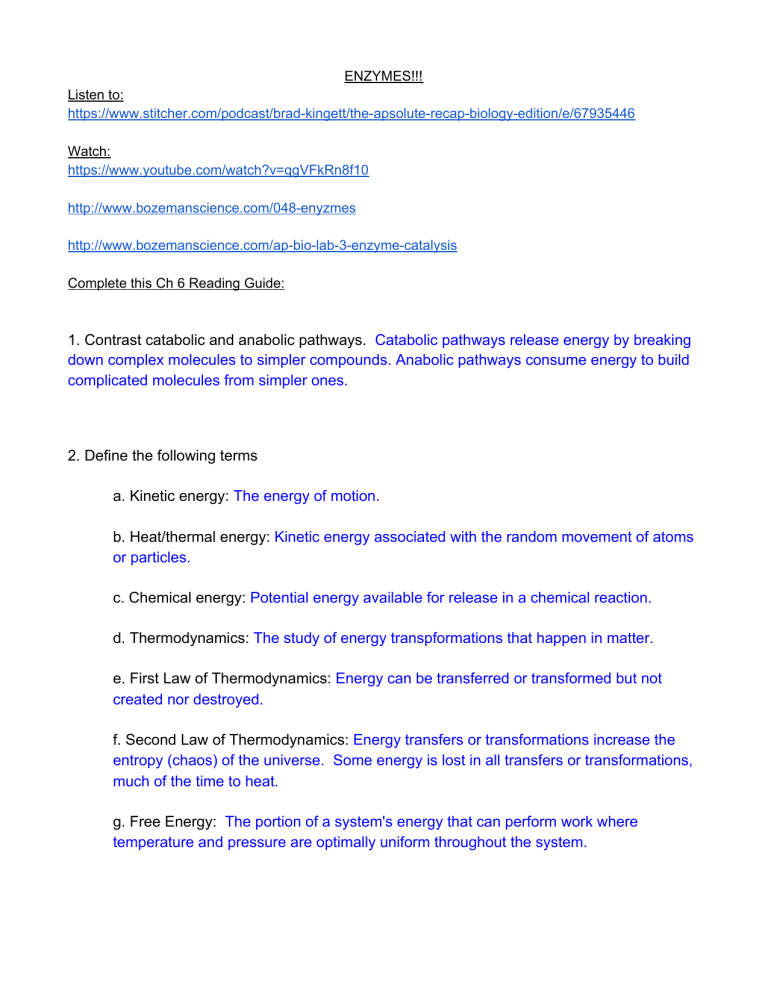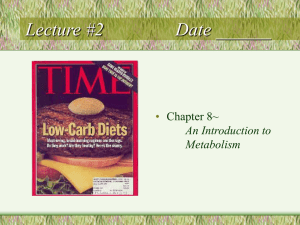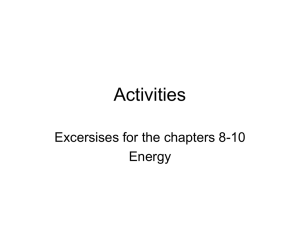
ENZYMES!!! Listen to: https://www.stitcher.com/podcast/brad-kingett/the-apsolute-recap-biology-edition/e/67935446 Watch: https://www.youtube.com/watch?v=qgVFkRn8f10 http://www.bozemanscience.com/048-enyzmes http://www.bozemanscience.com/ap-bio-lab-3-enzyme-catalysis Complete this Ch 6 Reading Guide: 1. Contrast catabolic and anabolic pathways. Catabolic pathways release energy by breaking down complex molecules to simpler compounds. Anabolic pathways consume energy to build complicated molecules from simpler ones. 2. Define the following terms a. Kinetic energy: The energy of motion. b. Heat/thermal energy: Kinetic energy associated with the random movement of atoms or particles. c. Chemical energy: Potential energy available for release in a chemical reaction. d. Thermodynamics: The study of energy transpformations that happen in matter. e. First Law of Thermodynamics: Energy can be transferred or transformed but not created nor destroyed. f. Second Law of Thermodynamics: Energy transfers or transformations increase the entropy (chaos) of the universe. Some energy is lost in all transfers or transformations, much of the time to heat. g. Free Energy: The portion of a system's energy that can perform work where temperature and pressure are optimally uniform throughout the system. 3. Contrast exergonic and endergonic reactions in terms of: free energy, stability, capacity to do work. Exergonic reactions release free energy, are more stable, and have less capacity for work while endogonic reactions absrob free energy, are less stable, and have more capacity for work. 4. How do you know if a reaction is spontaneous? A reaction is spontaneous if it releases free energy (has a negative delta G). The systems will also become more stable. 5. Can a closed system at equilibrium do work? Why or why not? A closed system at equilibrium cannot do work because systems at equilibrium are at a minimum of free energy. A cell that reaches the metabolic equilibrium is dead. 6. List the three main kinds of cellular work done by ATP and give an example of each. Chemical Work: synthesis of polymers from monomers. Transport Work: pumping substances across membranes. Mechanical Work: contraction of muscle cells. 7. Label the diagram below and indicate how cellular work is done by ATP. ATP is at the top in the yellow box. The blue oval is an enzyme. The enzyme removes a phosphate group (small yellow circle) from the ATP to turn it into ADP (molecule to the right of the small yellow circle). This is an exergonic process that releases energy (large faded yellow circle) which can be used to do work. 8. What is energy coupling? Energy coupling occurs when the energy produced by one reaction or system is used to drive another reaction or system. 9. Examine Figure 6.9. How is ATP used to do cellular work? An enzyme breaks ATP into ADP and a spare phosphate group. This exergonic process releases free energy that can be used to do cellular work 10. See Figure 6.11. What is the relationship between exergonic reactions, endergonic reactions and the use and regeneration of ATP? When ATP is used and broken into ADP and a spare phosphate group, this is an exergonic reaction. When ATP is regenerated via the fusion of ADP and a spare phosphate group, this is an endergonic reaction. 11. What is activation energy? Activation energy is the energy required for a chemical reaction to take place. 12. Label the diagrams below including the change in free energy. The black curve represents a chemical reaction without an enzyme and the red curve is the same chemcial reaction with the assistance of an enzyme. The upper black arrow represents the activation energy of the enzymeless reaction and the red arrow represents the lower activation energy of the reaction with an enzyme. The lower black arrow shows that the reaction is a exergonic one because it ends with less energy than it started with so energy must have been released. The upper black arrow represents the activation energy of the chemical reaction. The lower black line represents the change in free energy which in this case is negative so energy was releasing mean the black curve shown is an exergonic reaction. The dots shown to the left are the reactants and the dots to the right are the products. The dots in the middle are in the process of their bonds being rearranged. 13. Define the following terms: a. Substrate: The reactant an enzyme acts on. b. Enzyme-substrate complex: An enzyme bonded to its substrate. c. Active site: The part of the enzyme that binds to its substrate. d. Induced fit: When an enzyme changes the shape of its active site so that a substrate can better fit into it. 14.Label the following diagram: The large purple shape is an enzyme. The orange and blue shapes are the substrate reactants to that enzyme. The blue and yellow shapes are the products created by the reaction hasted by the enzyme. 15. How do temperature and pH (specifically) affect enzyme activity? (a) Temperature: Enzymes have optimal temperatures at which they work. Too high of a temperature denatures the enzyme and changes the active site. (b) pH Enzymes have optimal pH’s at which they work. Too high of a pH denatures the enzyme and changes the active site. 16. Compare cofactors and coenzymes. What is their function? Both cofactors and coenzymes bond with to active site or substrate to assist the enzyme in building up or breaking down substrates into products. Cofactors are typically metalic ions while coenzymes are organic molecules. 17. Compare and contrast competitive and noncompetitive inhibitors. Both inhibitors block the entry of substrates into an enzyme’s active site. Competitive inhibitors do this by taking the spot of the substrate in the active site while noncompetitive inhibitors do this by bonding to the enzyme somewhere else but still blocking entry into the active site or denaturating the enzyme by altering the shape of its active site. 18. What is allosteric regulation and how does it assist in the regulation of metabolism? A case in which a protein’s function at one site is affected by the binding of a regulatory moecule to another site. It assists in the regulation of metabolist by either inhibiting or stimulating enzyme activity. 19. What is cooperativity? Cooperativity is a phenomenon displayed by enzymes or receptors that have multiple active sites where the affinity of the active sites for a substrate is increased (positive cooperativity) or decreased (negative cooperativity) upon the binding of a separate substrate to a binding site. 20. How does feedback inhibition work? Feedback inhibition works by deactivating an enzyme using the product of the reaction the enzyme catalyzes.



